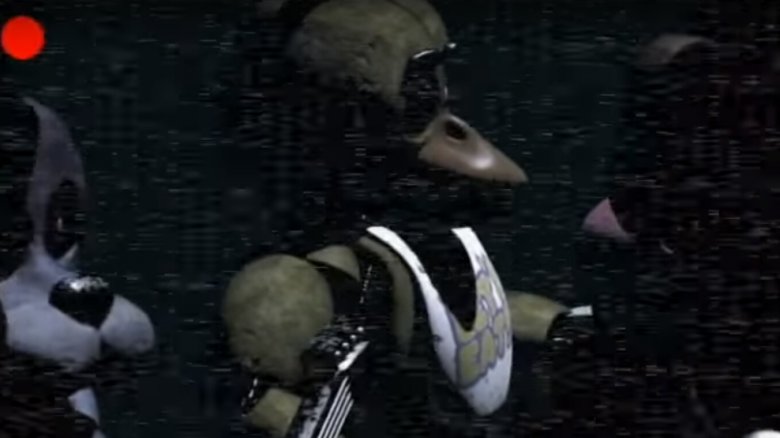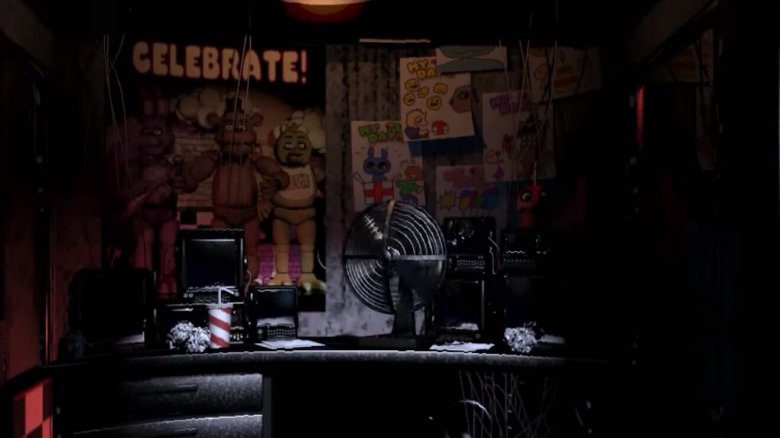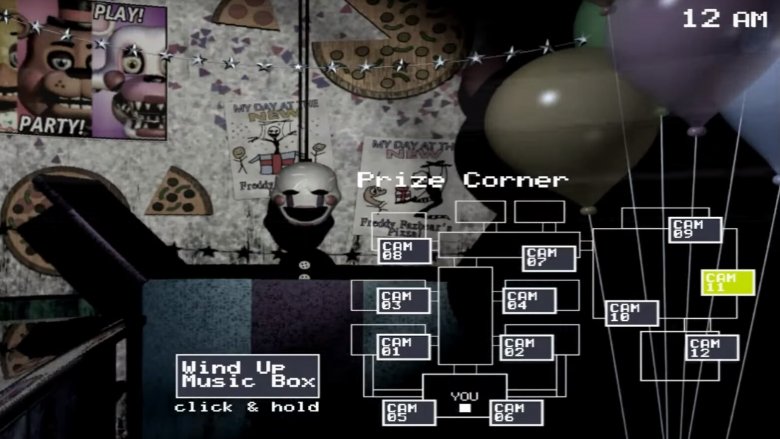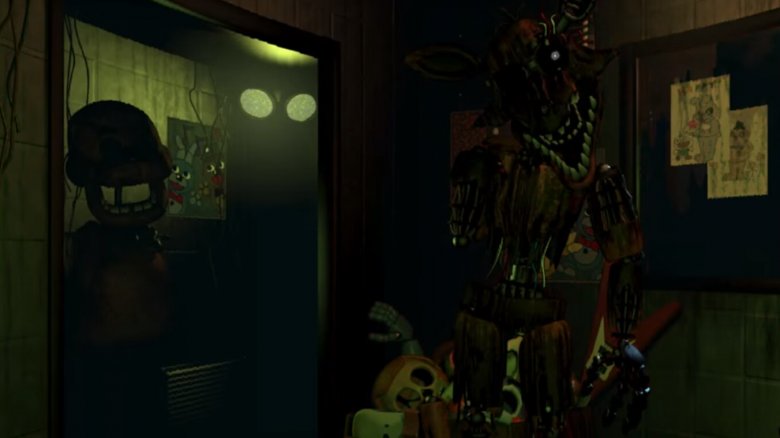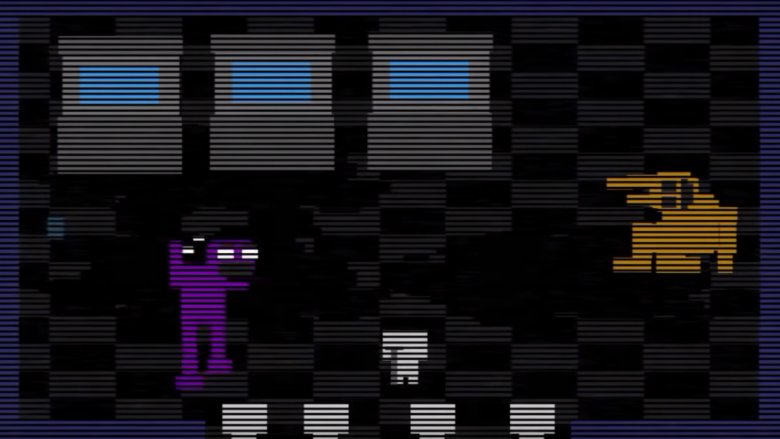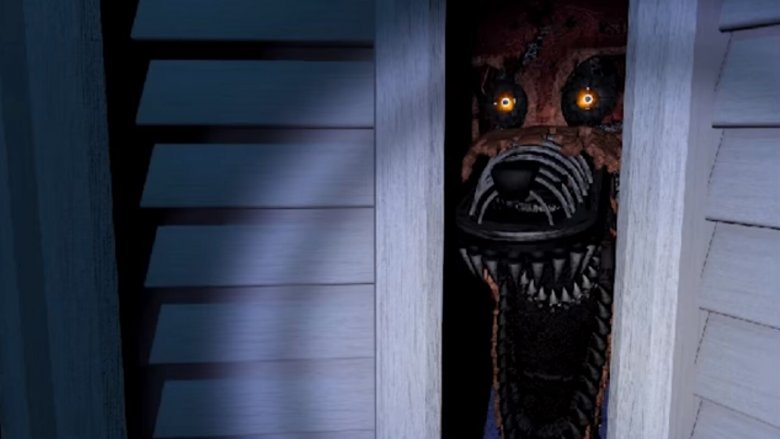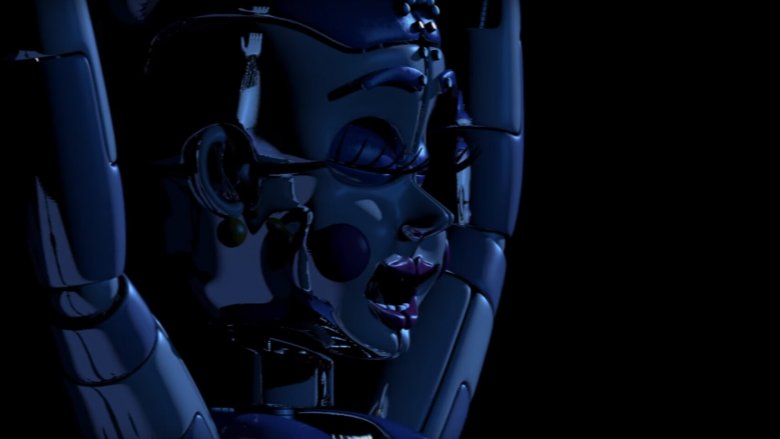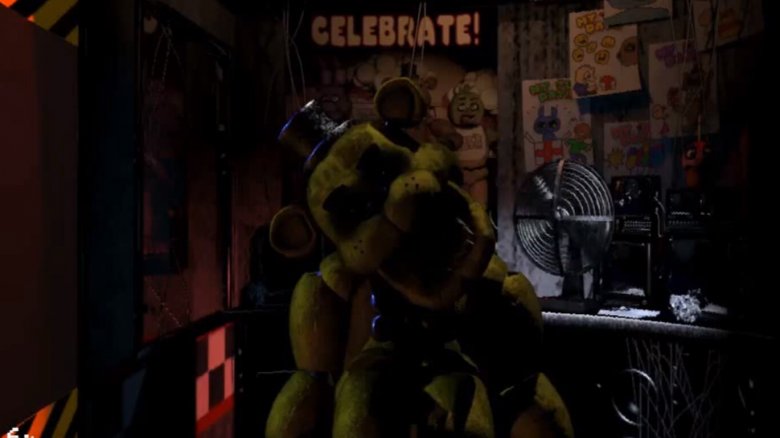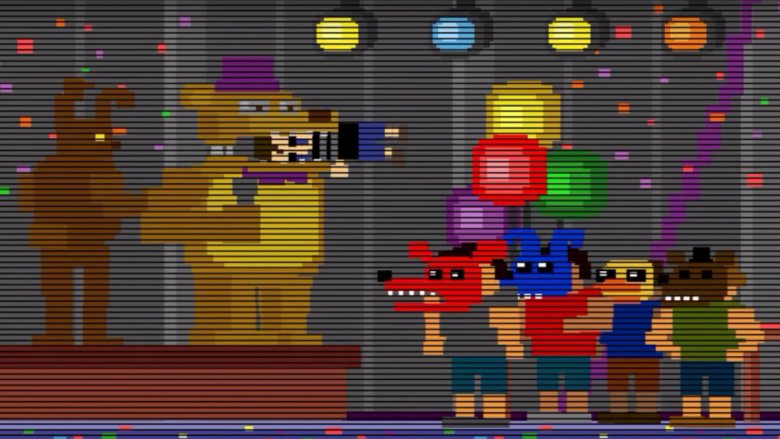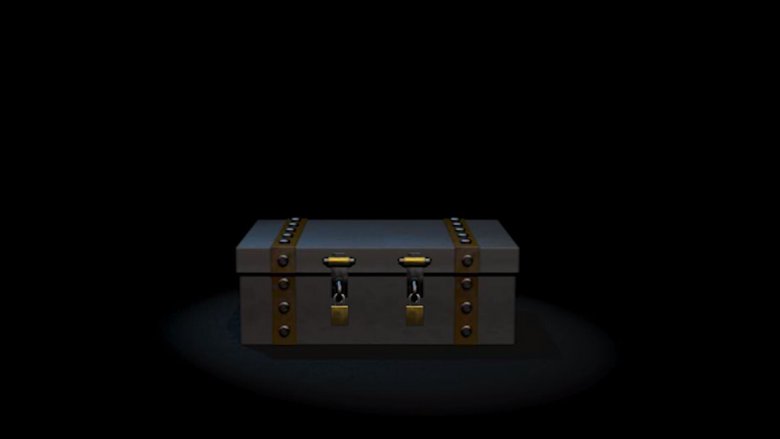Scariest Five Nights At Freddy's Game Moments We Need In The Movie
Every creator stumbles into failure now and then. The best know how to find gold where they've fallen and dig themselves out in unexpected directions. That's what game developer Scott Cawthon did after his early attempts at cute characters were lambasted by critics for looking like "scary animatronic animals." Leaning into this setback, he created Five Nights at Freddy's, and changed the horror game landscape for years to come.
In the short time since the first game's release in 2014, there have been five sequels, a spinoff, and multiple novels and guidebooks. Five Nights at Freddy's toys overflow from the shelves of the retail stores Cawthon worked in while honing his skills. A movie is the next logical step, but Freddy Fazbear's journey to the screen has been fraught with complications of its own.
After being announced in 2015 as a Warner Bros. production, "delays and setbacks" kept the movie in the dark until Blumhouse gained control and announced Chris Columbus as writer/director. Columbus, best known for glossy family fare like Home Alone and the first two Harry Potter films, may seem like an unusual choice, until you recall that he began his career with the screenplay for Gremlins.
That kind of anarchic horror/comedy twist might be exactly what's needed for this tale of haunted robots in a deranged pizzeria. Just as Cawthon spun failure into success, the Five Nights film's troubled production could still lead to a fun, spooky time at the movies. We've got some thoughts about which elements from the games are essential inclusions, and have rounded them all up for this look at the scariest Five Nights at Freddy's game moments we need in the movie.
The wait
The most important element in capturing the spirit of Five Nights at Freddy's is the wait. Though the games rose to prominence largely through videos of players reacting to the jump scares, what really makes them work is what comes between the screams. Where so many horror games (and movies) focus all their energy on throwing frights in your face or startling you with cheap, loud sounds, FNaF works to build a real sense of dread.
Very little happens in the opening moments of the first game, as the player begins flipping around the various security camera angles at their disposal. Aside from the ominous sound of humming fans, nothing seems alarming at first. It's only after a couple rounds through the cameras that you might notice the animatronic entertainers aren't quite where you last saw them. With paranoia building every time a rattling sound echoes down the hallway, the game achieves tension with the restraint of the best horror movies.
The Phone Guy
"Hello, hello?" For Five Nights at Freddy's fans, the voice of the "Phone Guy" (provided by Cawthon himself) is an unforgettable part of the Fazbear experience. Cleverly blending story with instruction, the Phone Guy's messages open each night of the game, setting the tone with chipper yet ominous warnings about the player's duties as security guard. The eventual revelation that the man on the other end of the calls has been dead all along is one the game's eeriest — if not outright scariest — moments.
The Five Nights movie should definitely make use of the Phone Guy. Not only will fans expect him, but he's an effective tool for conveying plot exposition and mood. Making a telephone your only human connection achieves a sense of isolation that needn't be discarded in the translation to a new medium. Cawthon hired voice actors for later games in the series, but his performance is quite good, and a cameo in the movie would be a nice nod to the man who single-handedly laid the foundation for a phenomenon.
Pop goes the puppet
The Five Nights at Freddy's games are quick to play, and a feature film will likely need to draw inspiration from the entire series to flesh out its story. Like any good sequel, the second game ups the ante by introducing a dynamic new character, the Puppet. Players must keep this malevolent marionette at bay by winding a music box that keeps it placated. If the encroaching animatronic assault of Freddy and friends distracts you from this duty, the Puppet leaps lethally from its box.
A good horror movie engages your senses with all the tools at its disposal, and music can be a big part of that. The tinkling chimes of a creepy music box might be more than a little cliché, but used in tandem with the tension of the terrible automatons, they could still be very effective. The gradual slowing of the tune that signals impending doom holds a lot of cinematic potential.
Phantom fake-outs
Five Nights at Freddy's 3 shakes up the formula by jumping forward 30 years to Fazbear's Fright, a horror attraction based on the urban legends surrounding the pizzeria of the previous installments. It shakes up players as well, by requiring them to manage the building's ventilation systems. There's only one deadly animatronic this time, a rotting rabbit suit known as Springtrap that may or may not have a living person inside, but the game is more frightening than ever.
Blocking the vents can protect you from the robot that's coming to kill you, but the lack of air will cause you to hallucinate phantom creatures bent on attacking and distracting you. These spooky apparitions force players to stay focused on the difference between real danger and illusion. The movie could pay homage to this game mechanic with ghostly visages in the corners of the frame that vanish upon closer inspection, driving paranoia by making audiences doubt their senses.
Ghosts in the machines
Just about anyone who's spent more than ten minutes on the internet in the past few years knows that the basic premise of Five Nights at Freddy's is Chuck E. Cheese-like robotic entertainers coming to life. What doesn't become evident until you actually play the games is that there's a surprisingly dense backstory hinting at what makes their gears tick. As the franchise continues, a story of generations-deep family drama, murder, and madness unfolds.
Cawthon never simply spells out the gory details, however, which is part of why the FNaF fandom is so alive with discussions, theories, and speculations. From the moment players spotted newspaper clippings about missing children hidden in the first game, the hunt for lore was on. Many hints would later come in the form of old school arcade or Atari-style minigames filled with metaphors and clues about the history of Freddy Fazbear's Pizza.
Though their function would naturally be very different in a movie, these games are so integral to the fabric of Five Nights that the filmmakers would be remiss in ignoring them. Maybe the screen version of the cursed restaurant could have haunted machines replaying past traumas before the eyes of disbelieving patrons. An especially effective moment worth recreating comes from the sixth game, Freddy Fazbear's Pizzeria Simulator, in which the reflection of something standing behind the player slowly becomes clear in a cabinet's screen.
New nightmares
The creep factor in the character designs of Five Nights at Freddy's rests squarely in the Uncanny Valley, in the way that ostensibly friendly robotic characters so often look just slightly wrong. The effectiveness of that approach was bound to wear off as the series went on, however, so for Five Nights at Freddy's 4, Cawthon introduced a whole new angle on his mechanical menagerie. This entry places players in a child's bedroom and forces them to confront horrific "nightmare" incarnations of Fazbear and friends.
It's a successful reinvention. With the more relatable domestic setting, unearthly electronic drones dominating the soundscape, and the outlandish aggressiveness of the creature designs, the fourth game may well be the scariest in the franchise. Just as this shake-up kept the games from growing stale, the movie could deploy these redesigns just as the audience becomes accustomed to the robots. A Carrie-style finale could find surviving characters haunted in their dreams by "Nightmare Freddy," leaving the audience with the feeling that they will never truly be free from the horror.
Dancer in the dark
Another reason that fans never get tired of the Five Nights at Freddy's games is Scott Cawthon's dedication to introducing new play mechanics at every turn. For instance, the fifth entry in the series, Sister Location, proved to be a vast departure from its predecessors. Here, players are no longer tasked with sitting in place and keeping monsters at bay; instead, they're required to venture out into a facility crawling with danger.
New characters make an entrance as well, including the deceptive Baby and a graceful ballerina bot named Ballora. A highlight of Sister Location finds the player traversing a pitch black room, listening intently for the sound of Ballora's gentle music. Failure to freeze when she draws near is punished with instant death. Translating this scene to the big screen would give the filmmakers an outstanding opportunity to experiment with sound design. Clever surround mixing here could wow audiences in a way few horror films do.
Golden Freddy breakdown
One of the most remarkable moments in Five Nights at Freddy's isn't even seen by everyone who plays it. The first game features an entity known as Golden Freddy, a variation on everyone's favorite killer bear robot that will occasionally appear without regard to the rules that govern the other animatronics. His face fills the screen almost subliminally, and if the player doesn't shake him off in time, the game itself crashes and resets.
The effect is truly unsettling. Seemingly kicked out of the game and left staring at your desktop, you may well feel that the evil spirits are loose in your very computer. The movie has a fantastic opportunity to use this concept to pay homage to some classic horror films.
Flashing frames of Freddy faces would freak out audiences just as The Exorcist's subliminal demon visages do. Even more fun could be had by picking up the tradition of William Castle's "frame-breaking" gimmicks, which were memorably referenced in Gremlins 2: The New Batch. Plunge the theater into darkness and "reboot" the movie itself to get Freddy out of the projection booth, and the crowd will go wild.
The Bite of '87
If there's one particular scene that Five Nights at Freddy's fanatics will be expecting to see when they plunk down their cash at the box office, it's probably the infamous "Bite of '87." First referenced by the Phone Guy as the reason the animatronics are no longer allowed to roam freely during business hours, this fateful malfunction quickly became a legendary turning point in the FNaF lore.
The fourth game finally showed the event, albeit in low-res minigame form, as players watched a small child's head get crushed in a pair of animatronic jaws. The movie, too, will likely have to lessen the impact of this gruesome scene, as an R rating would keep most of the games' young fanbase from seeing it. Depicting the bite via distorted security camera footage could squeak past the MPAA and underline the subconscious impact of the violence, all while staying true to the aesthetics of the games.
The box
The ending of Five Nights at Freddy's 4 deserves to be on any list of the scariest Five Nights game moments we need in the movie because it presented fans with an object that has fascinated and frustrated them more than any other: a box. A double-padlocked steel case that just sits on your screen, it won't open no matter how you attempt to interact with it. According to Scott Cawthon, the box contains "the pieces put together." Cawthon briefly considered ending the series there, considering the elusiveness of his story's answers to be "a fitting conclusion."
The FNaF movie might not feature a literal mystery box, but it would do well to remember what it represents about unanswered questions. Cawthon's ability to dole out hints is what keeps the legions of Fazbear fanatics coming back to the series, even if they know he will never fully answer their questions. They wouldn't want him to, whether they realize it or not. The movie might reinvent old mysteries and introduce new ones, but if it knows its audience, it'll keep the answers just out of reach.
